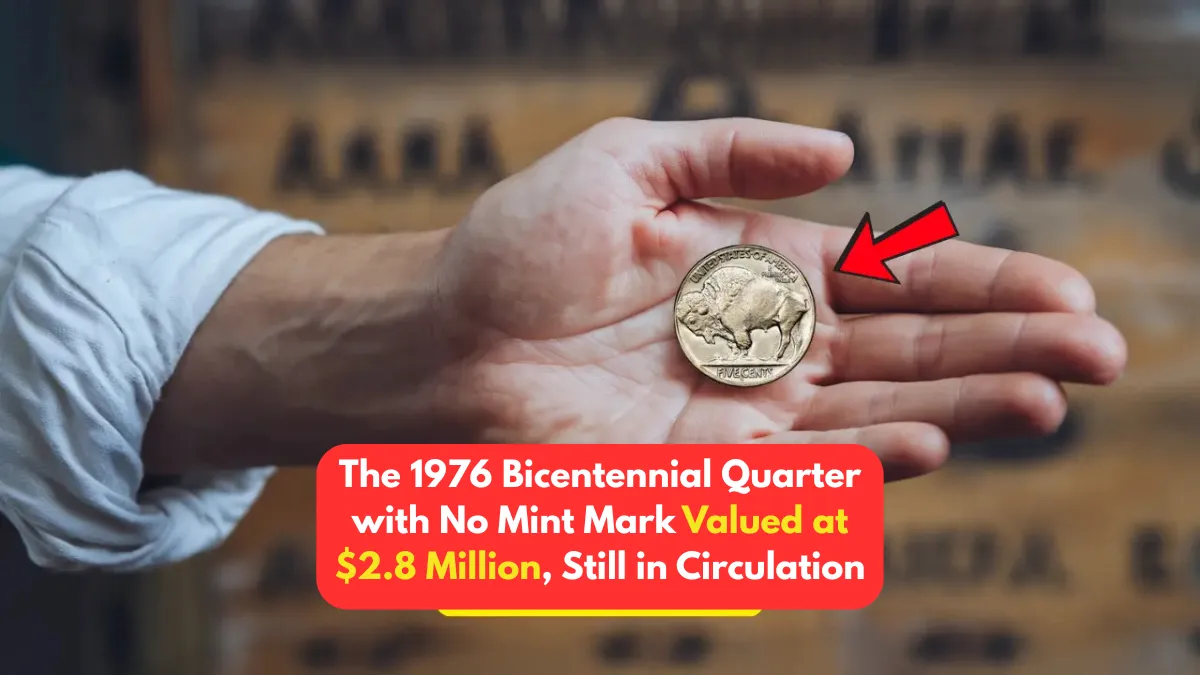In the world of coin collecting, the unexpected often becomes reality. One of the most talked-about U.S. coins right now is the 1976 Bicentennial Quarter with no mint mark, which has been valued at an astonishing $2.8 million. What makes this even more exciting? This coin is reportedly still in circulation, meaning it could be sitting unnoticed in someone’s pocket, coin jar, or couch cushion.
As Americans celebrated the 200th anniversary of independence in 1976, the U.S. Mint released a special series of commemorative coins. Among them, the Bicentennial Quarter stands out—but a rare error version of it stands even higher, becoming one of the most valuable modern U.S. coins ever discovered.
A Quick History of the 1976 Bicentennial Quarter
To honor the United States Bicentennial, the U.S. Mint released special editions of the quarter, half dollar, and dollar coins. These were minted from 1975 through 1976, and all of them bear the dual date “1776–1976” on the obverse to commemorate two centuries of American independence.
Key Design Elements:
- Obverse: George Washington’s profile (unchanged)
- Reverse: A colonial drummer with a torch encircled by 13 stars (designed by Jack L. Ahr)
- Mint locations: Philadelphia (no mint mark), Denver (“D”), and San Francisco (“S”)
Most of these quarters are common, but a very rare variety without a mint mark and with unique die errors or striking characteristics is the one that commands multi-million-dollar attention.
The $2.8 Million No Mint Mark Bicentennial Quarter
Not all 1976 quarters without a mint mark are valuable. What makes this particular coin worth $2.8 million is a combination of extreme rarity, minting errors, historical significance, and collector demand.
What Makes It Valuable?
- No Mint Mark: Though many quarters from Philadelphia have no mint mark, this particular no-mark coin was struck with a proof die, which shouldn’t have been used in general circulation. This error is extremely rare.
- Struck on the Wrong Planchet: Some valuable varieties were accidentally struck on 40% silver planchets (meant for collector sets), instead of the usual copper-nickel ones.
- Sharp Details & Die Errors: The coin in question may show striking anomalies, doubling, or unique die markers that make it one-of-a-kind.
- Immaculate Condition: The high value is tied to the coin’s preservation—graded at a near-perfect level (MS-68 or higher).
- Private Sale Value: While auctions often cap values, private collectors are known to pay premium prices for exclusive coins—hence the $2.8 million valuation.
How to Identify the Rare 1976 No Mint Mark Quarter
If you’re eager to check your spare change, here’s a step-by-step guide to spotting this elusive coin:
Step 1: Check the Date
Look for the dual date “1776–1976” on the front (obverse).
Step 2: Look for the Mint Mark
- Located just to the right of Washington’s hair ribbon
- If there’s no mint mark, it could be Philadelphia—or something rare
Step 3: Examine the Material
- Regular circulation coins: Copper-nickel clad
- Rare variety: Struck on 40% silver planchets
- Use a scale: Silver coins weigh 5.75 grams vs. the normal 5.67 grams
Step 4: Check the Rim and Edge
- Silver coins have a solid silver-colored edge
- Clad coins show a copper stripe on the edge
Step 5: Look for Proof-Like Features
The million-dollar coin was struck using a proof die—so even without a mirror finish, you may notice:
- Sharper design details
- Crisper, more refined edges and letters
How Rare Is This Coin?
The 1976 Bicentennial Quarter was minted in the billions, but only a handful of these error no mint mark coins struck with proof dies or on silver planchets are known to exist. Some were mistakenly released into circulation, making them extremely valuable to collectors.
In the case of the $2.8 million specimen, experts believe only one or two may exist in such pristine condition and with the same set of unique errors—making it essentially one-of-a-kind.
Have Other Bicentennial Quarters Sold for Big Money?
Yes, several rare and error versions of the 1976 quarter have fetched large sums:
- 1976-S Silver Proof Quarter – Can sell for $50–$500 depending on condition
- 1976 Double Die Obverse/Reverse – Valued from $300 to $3,000+
- Full-strike, high-grade coins (MS-68 or better) – Sell from $1,000 to $15,000
- But none compare to the $2.8 million no mint mark, silver error coin
Could This Coin Still Be in Circulation?
Yes. That’s the mystery—and the thrill. It’s widely believed that at least one of these rare no mint mark Bicentennial Quarters is still out there, possibly misidentified as an ordinary coin. If it has passed from hand to hand over the decades, it may have eluded detection simply because of how common 1976 quarters are.
Coin collectors and hobbyists regularly search bank rolls, old change jars, and cash drawers hoping to strike gold—or, in this case, silver.
Tips for Coin Hunters
If you want to join the hunt for rare coins like the $2.8 million Bicentennial Quarter, here are a few tips:
- Get a magnifying glass or jeweler’s loupe
- Use a precise coin scale for weighing
- Sort your quarters by year and inspect each carefully
- Look for key signs of mint errors or unusual finishes
- Join numismatic forums or communities to compare photos and get second opinions
- Always consult a professional grader (like PCGS or NGC) if you think you’ve found something extraordinary
Final Thoughts: Is That Quarter in Your Pocket Worth Millions?
While the odds of finding the exact $2.8 million Bicentennial Quarter are slim, they’re not zero. And the possibility that such a coin is still in circulation has given new life to the hobby of coin collecting. With a little patience, a sharp eye, and a bit of luck, you might just uncover a piece of numismatic history hiding in plain sight.
So before you drop that old quarter into a vending machine, take a second look—it could be worth far more than twenty-five cents.
